Concrete slab-on-grade foundations should be easy to insulate…but they are proving not to be easy to insulate. We were here more than a half decade ago (BSI-059: Slab Happy, April 2012) and again a couple of years ago (BSI-096: Hot and Wet But Dry, June 2016). It is apparently time again to go over what is working and what is not.
The absolute easiest slab-on-grade foundation to insulate is a stem wall….except….when it is not easy…. Some structural engineers hate stem walls…for good reason. Other structural engineers hate stem walls…not for good reasons…
First, for good reasons, when we have bad soil conditions, stem walls are difficult to make work. You are going to end up with a monolithic slab/grade beam that may also be post tensioned. They are a “bear” to insulate….but it can be done… Note this is a change in my opinion of a couple of years ago where I pretty much said it was not possible to do so practically. I still think it is a pain in the hind quarters. We will talk about how to do them later.
Second, for not good reasons, when we have good soil conditions, it is easy to make stem walls work…structurally. But some folks refuse to believe it and are making folks structurally connect stem walls to slabs. This is not necessary…and it results in major thermal bridging unless you insulate them externally. And wait till we talk about termites and rodents and external insulation. More about this later. Can we structurally connect stem walls to slabs and not get major thermal bridging without external insulation? Yes. And we will go there…but first the easy stuff.
The easy way to do things is to insulate a stem wall on the inside and thermally decouple the concrete slab from the stem wall. In this approach the stem wall is structurally disconnected from the slab. The stem wall is supported by a footing that is bearing on the soil. The concrete slab is supported by soil…it is bearing on the soil. Amazing, both the stem wall and concrete slab are supported by the same thing….the soil. They do not have to be connected to each other….except when they have to.[1]
Internally insulated stem wall foundations typically are insulated with two types of insulation – rigid board insulations - foam plastics such as extruded polystyrene (XPS) or expanded polystyrene (EPS) and semi rigid board insulation such as mineral wool/stone wool or fiberglass. Mineral wool/stone wool or fiberglass needs to be of sufficient density to support the slab – typically greater than 10 lbs/ft3.
All the insulations need to be installed over a granular capillary break. All of the insulations are capillary active even extruded polystyrenes (XPS).[2] This capillary break serves a second function. It provides for control of radon and other soil gas ingress when it is passively vented up through the roof to the atmosphere with a radon or soil gas vent. It gets better, this capillary break also acts as a “drainage pad” where ground water can be drained through the foundation wall to the exterior. You get a three-for-one….
And you need to seal the top of the slab – across the rigid insulation bond break – to the top of the stem wall using a masticed stainless steel mesh membrane strip. This is – and I use the next word with emphasis - absolutely necessary to provide a “termite barrier” and “insect barrier” and to provide air control layer continuity between the perimeter wall and the slab itself which is acting as the air control layer of the foundation.[3]
Extruded Polystyrene (XPS) or Expanded Polystyrene (EPS)
Figure 1 and Figure 2 show rigid board insulations - foam plastics such as extruded polystyrene (XPS) or expanded polystyrene (EPS) and semi rigid board insulation such as mineral wool/stone wool or fiberglass respectively. Both require a polyethylene vapor barrier in direct contact with concrete. Don’t even think of placing a sand layer between the polyethylene vapor barrier and concrete (see BSI-003: Concrete Floor Problems, May 2008).
In both Figure 1 and Figure 2 the insulation layers extend horizontally inward – typically 4 feet with a thermal resistance of R-10. This level of thermal performance exceeds the building code requirements for slabs by the International Energy Conservation Code (IECC) for Climate Zones 3 and 4….but it's recommended by me.[4]
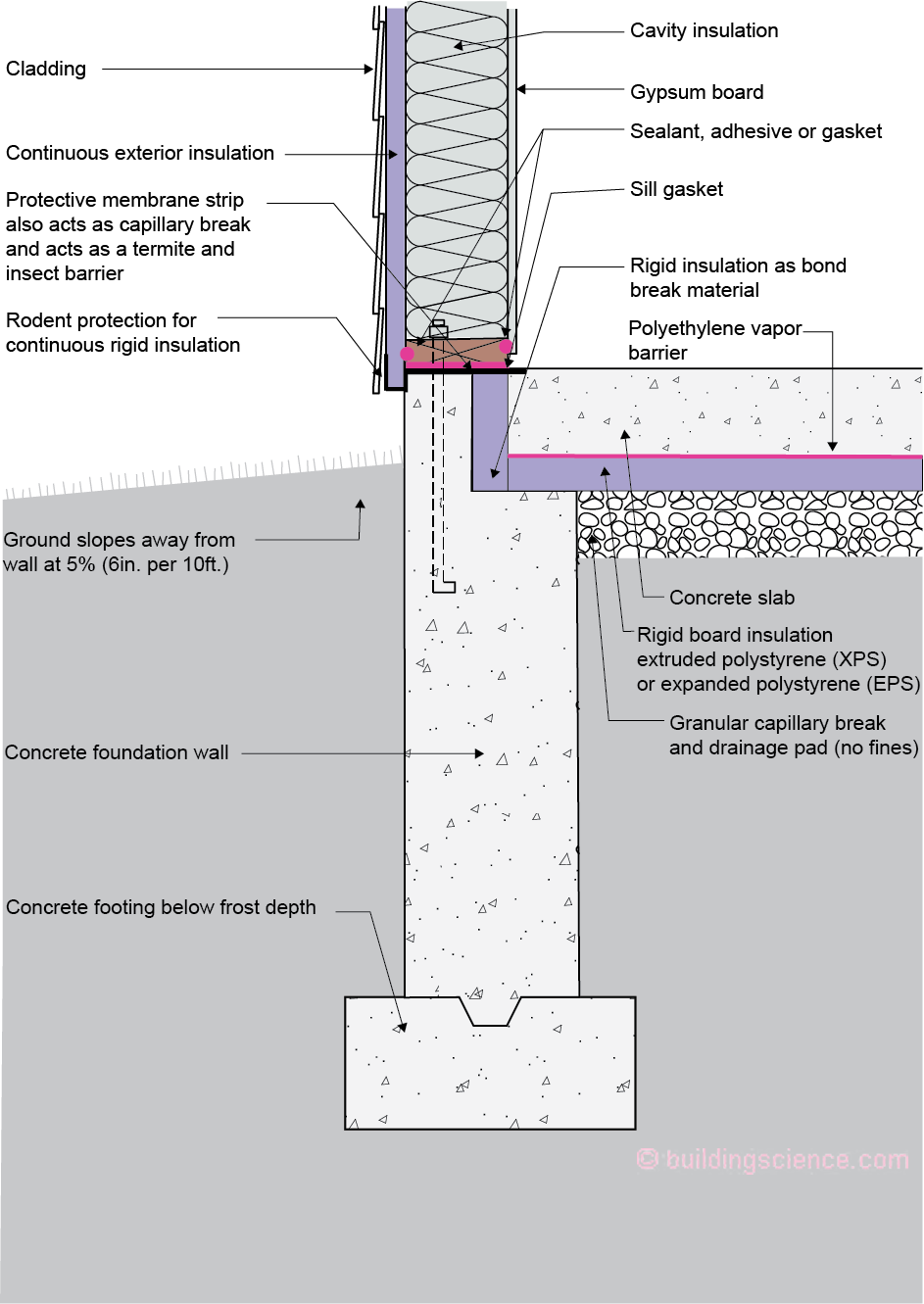
Figure 1: Stem Wall With Horizontal Insulation Extruded Polystyrene (XPS) or Expanded Polystyrene (EPS)
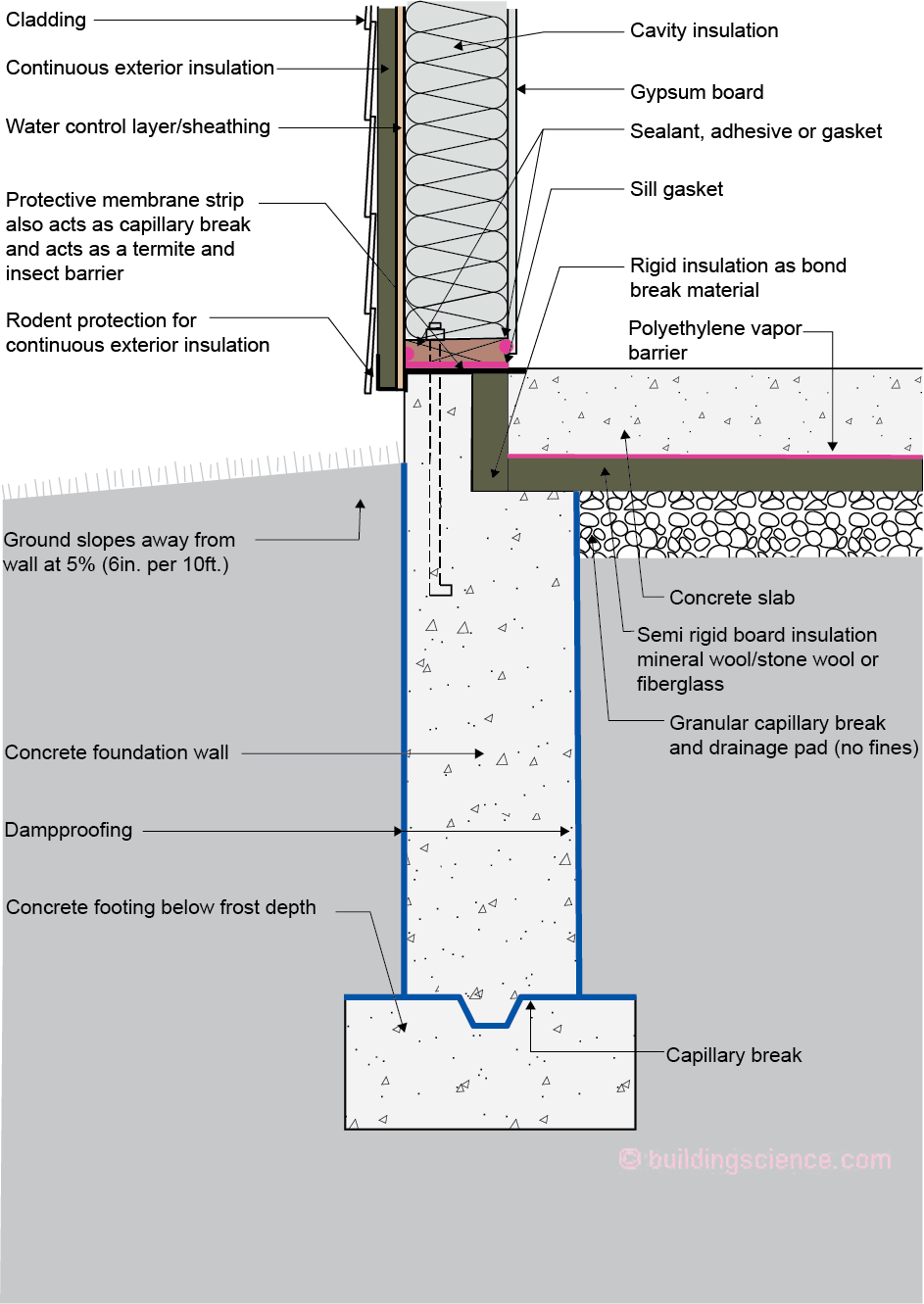
Figure 2: Stem Wall With Horizontal Insulation Semi Rigid Board Insulation (mineral wool/stone wool or fiberglass) Note the requirements for dampproofing the stem wall when using these types of board insulation.
Figure 3 shows both vertical and horizontal thermal insulation. This approach is recommended for International Energy Conservation Code (IECC) Climate Zones 5 and higher. The stem wall perimeter foundation can be insulated on the interior with extruded polystyrene (XPS) (Photograph 1) or expanded polystyrene (EPS). Note the depth of the “seat” in the top of the stem wall to accommodate the thickness of the rigid insulation yet to be installed and the thickness of the slab yet to be cast.
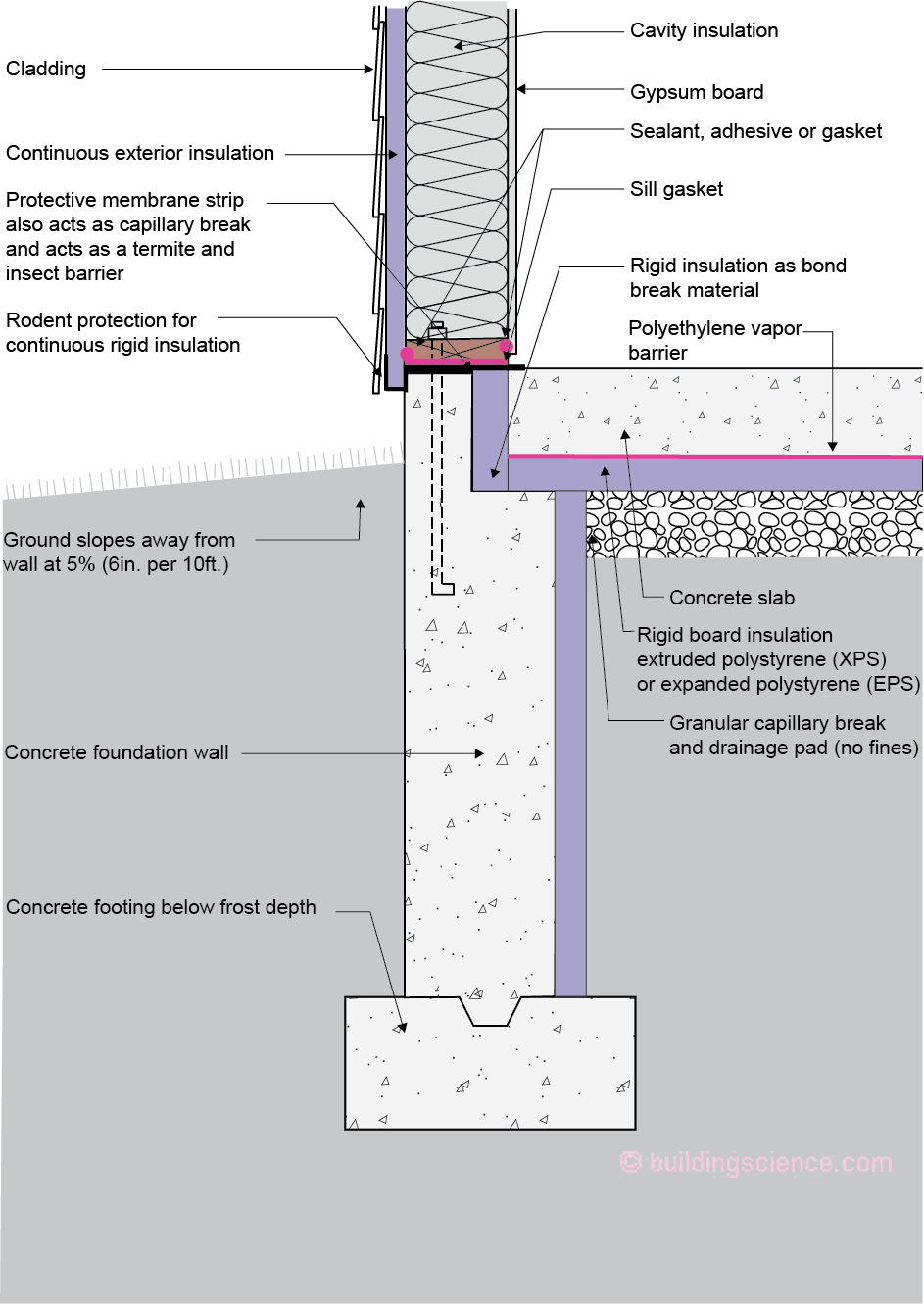
Figure 3: Stem Wall With Horizontal and Vertical Insulation Extruded Polystyrene (XPS) or Expanded Polystyrene (EPS)
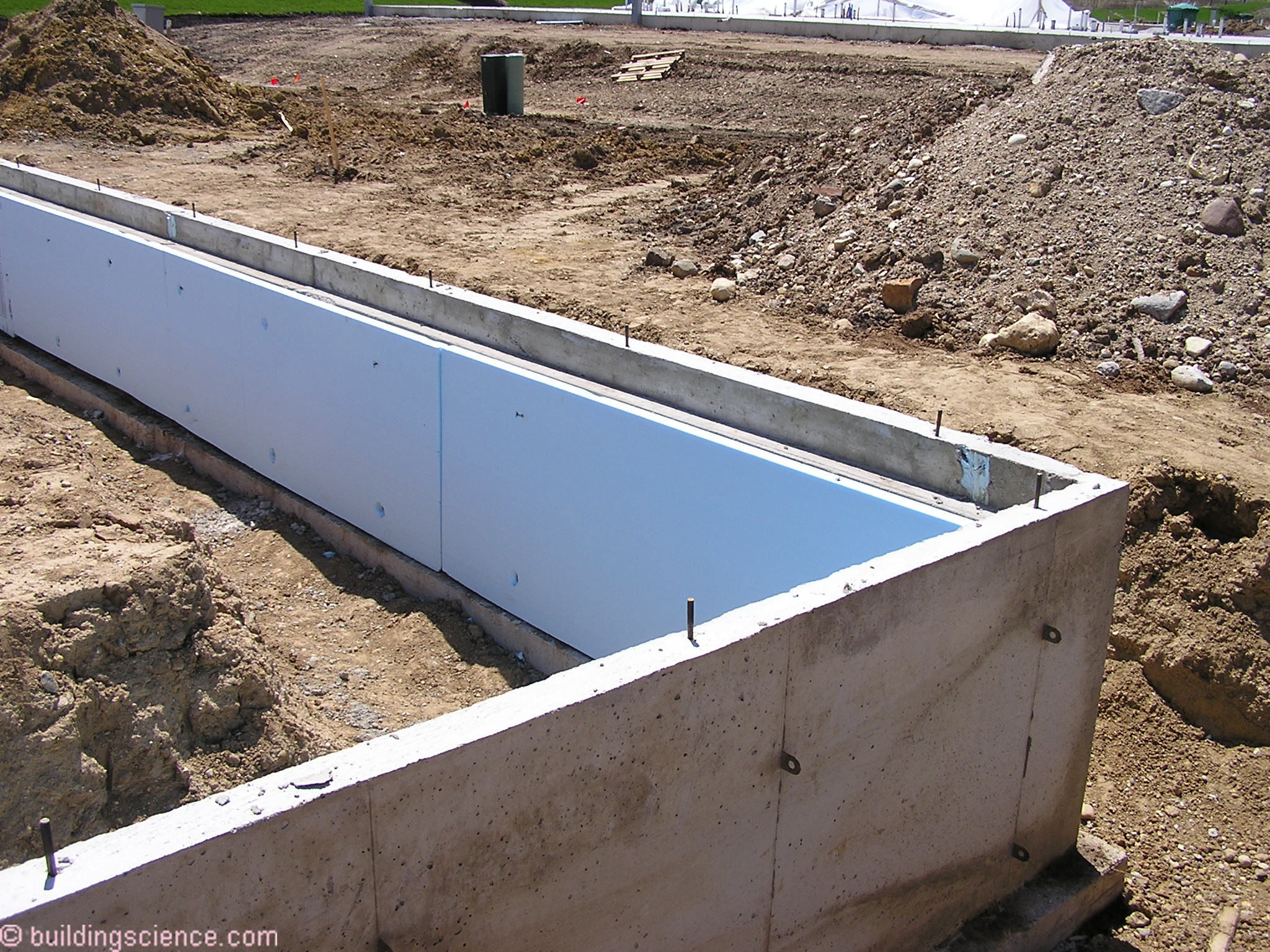
Photograph 1 - Stem wall perimeter foundation insulated on the interior with extruded polystyrene (XPS). Note the depth of the “seat” in the top of the stem wall to accommodate the thickness of the rigid insulation yet to be installed and the thickness of the slab yet to be cast.
Horizontal insulation should be covered with a polyethylene vapor barrier (Photograph 2). Note the vertical rigid insulation strip in the “seat” of the stem wall creating a thermal break between the yet to be cast slab and the support for the perimeter exterior wall framing. The stones on the top of the polyethylene sheet are being used to keep the sheet poly from blowing away before the slab is cast.
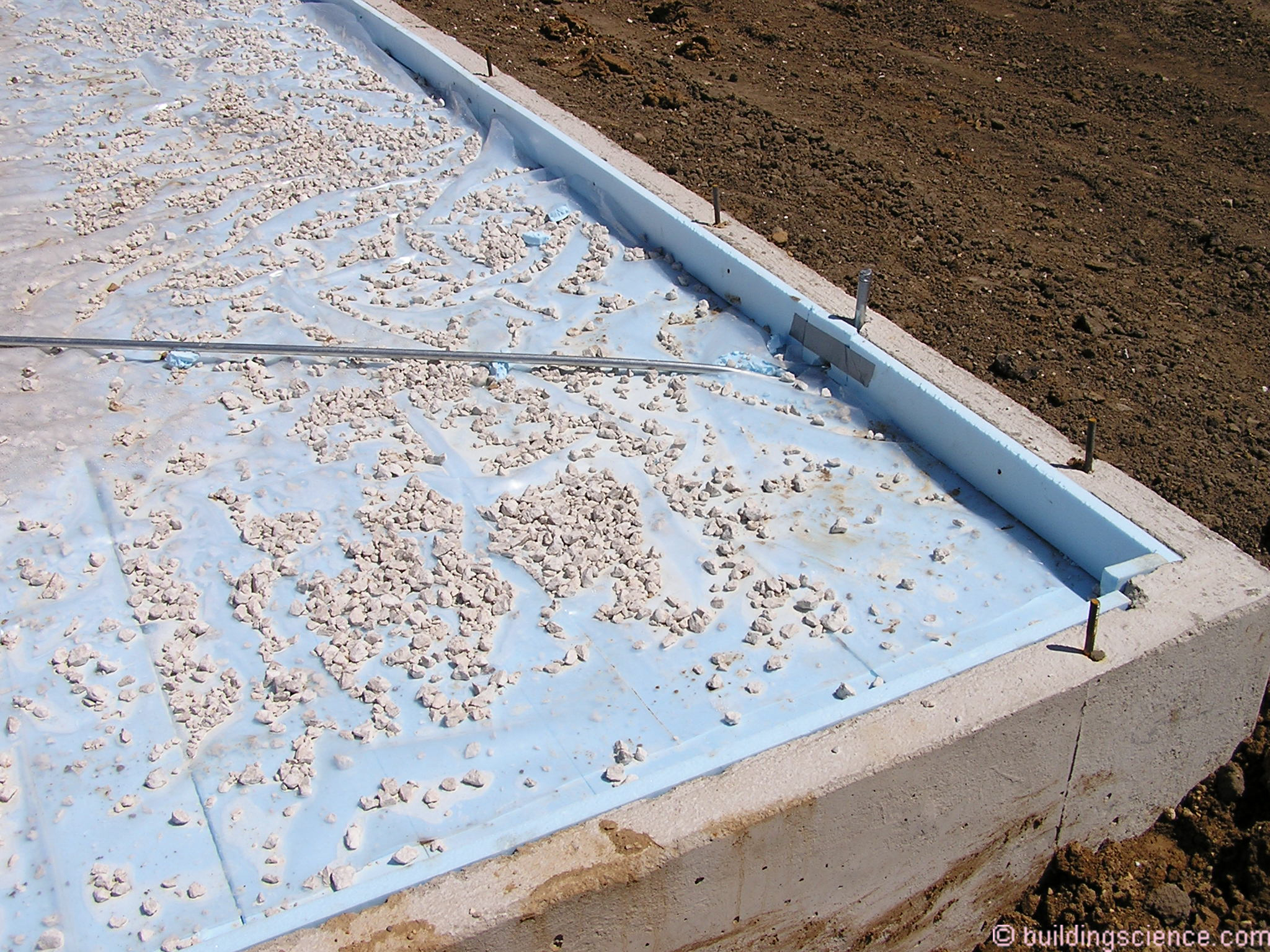
Photograph 2 - Horizontal rigid insulation installed covered with a polyethylene vapor barrier. Note the vertical rigid insulation strip in the “seat” of the stem wall creating a thermal break between the yet to be cast slab and the support for the perimeter exterior wall framing. The stones on the top of the polyethylene sheet are being used to keep the sheet poly from blowing away before the slab is cast.
The concrete slab is then cast (Photograph 3). Note that the protective membrane strip is yet to be installed. The protective membrane strip should bridge the top of the slab and the top of the stem wall. The protective membrane strip acts as a capillary break providing moisture control and acts as a termite and insect barrier.
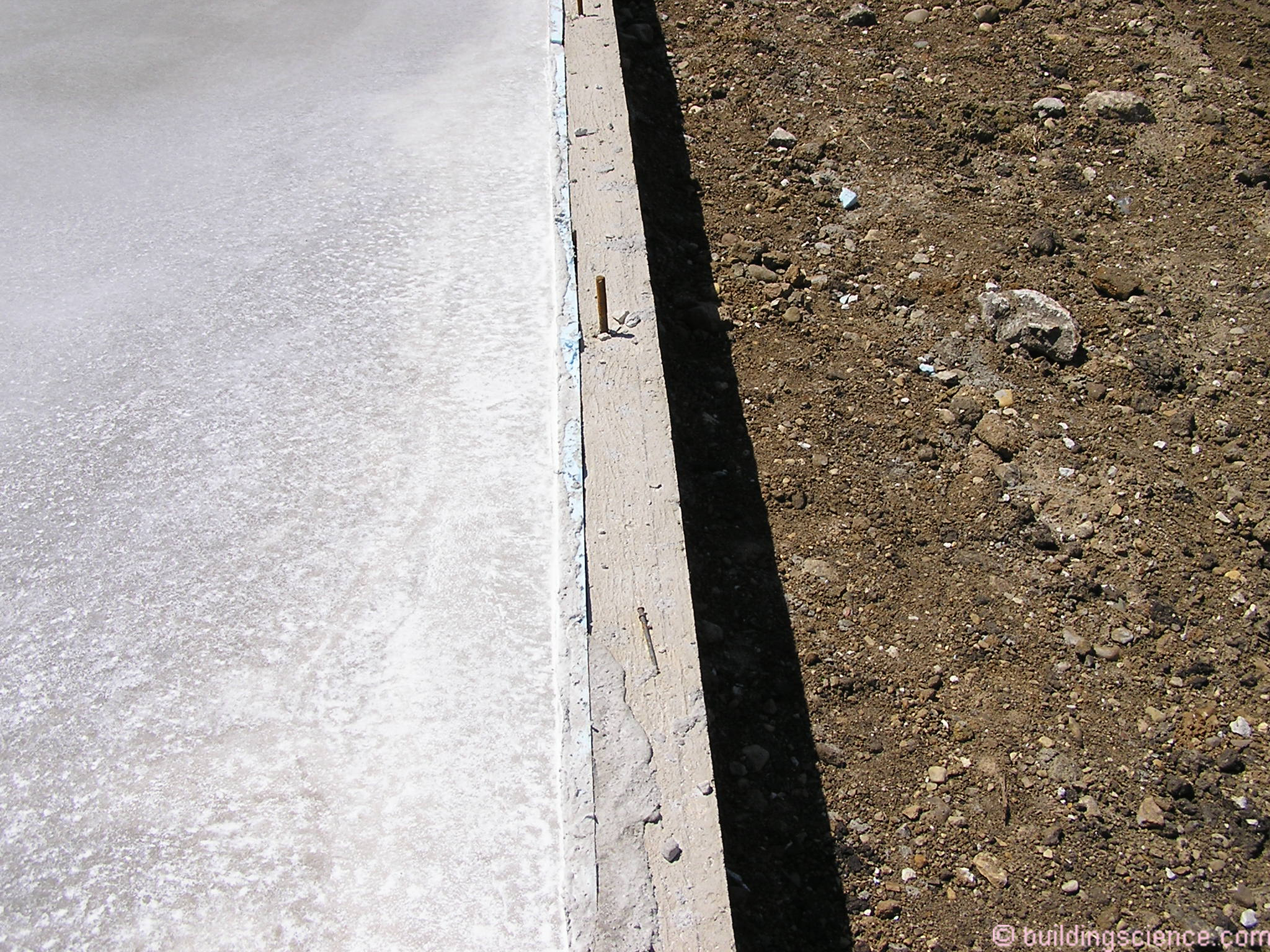
Photograph 3- Concrete slab is cast. Protective membrane strip yet to installed. The protective membrane strip should bridge the top of the slab and the top of the stem wall. The protective membrane strip acts as a capillary break providing moisture control and acts as a termite and insect barrier.
Figure 4 shows semi rigid board insulation such as mineral wool/stone wool or fiberglass installed both horizontally and vertically. The key to Figure 4 is that there must be an interior perimeter drain and a granular capillary break along the vertical portion – as well as the horizontal portion – of the mineral wool/stone wool or fiberglass layer. This is necessary in order to keep the mineral wool/stone wool or fiberglass layer from becoming saturated. This insulation layer can get intermittently wet as long as it is capable of drying. The granular layer and perimeter drain allow that to happen.
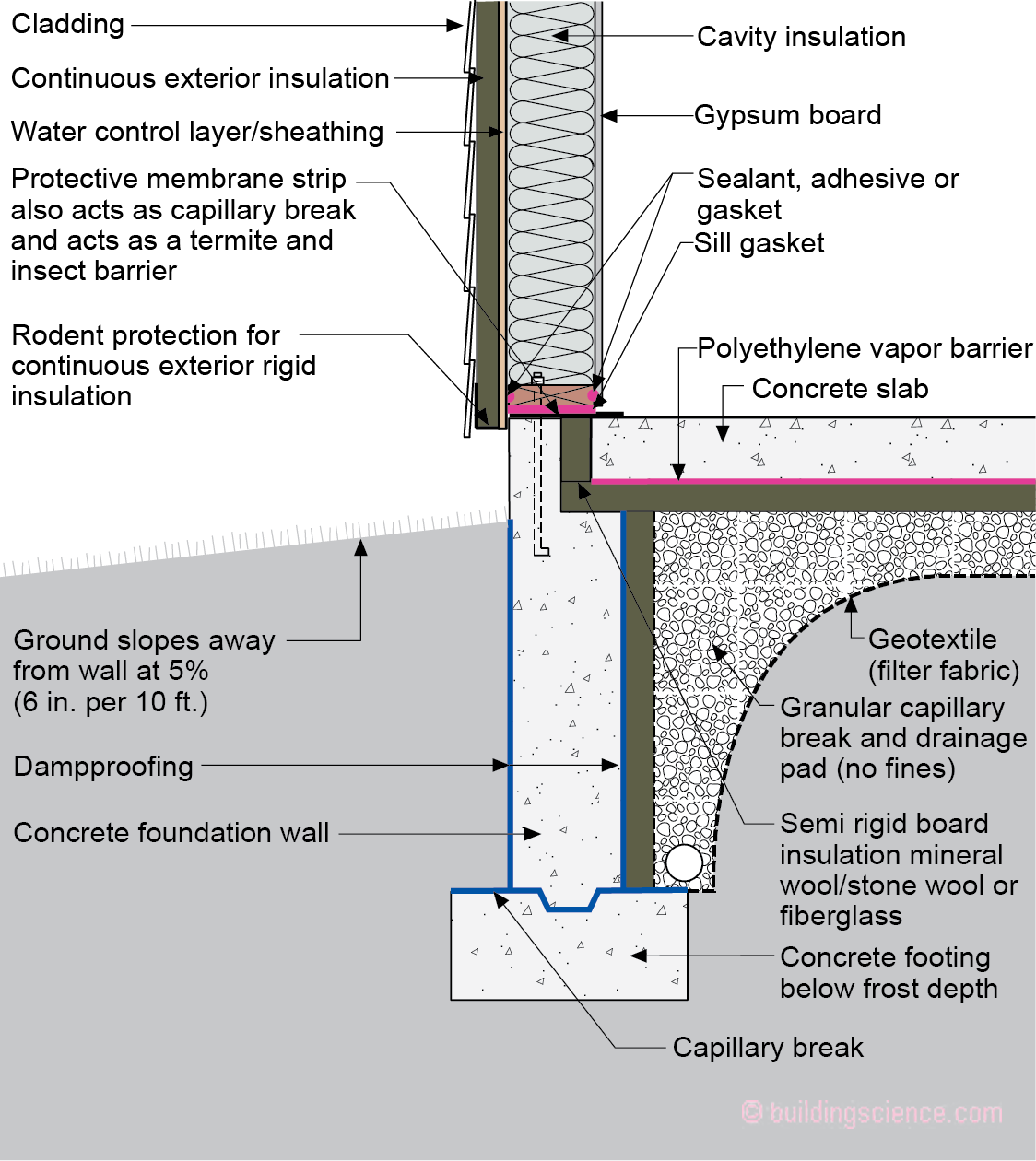
Figure 4: Stem Wall With Horizontal and Vertical Insulation - Foundation Stem Wall – Semi Rigid Board Insulation (mineral wool/stone wool or fiberglass) - Note the requirements for dampproofing and sub slab interior perimeter drainage for the stem wall when using these types of board insulation.
What if I want to (or need to) structurally connect the stem wall to the slab? And not do it with thermal bridging and not do it with external perimeter slab edge insulation? Use non-conductive reinforcing bars - fiberglass re-bars. Awesome (Photograph 4). Figure 5 and Figure 6 show how they can be used. With the approach in Figure 6 the rigid insulation strip is installed with the penetrating re-bar into the formwork prior to placing the concrete. The interior form has holes penetrating the form positioning the re-bar. The re-bar holds the rigid insulation in place while the concrete is placed.
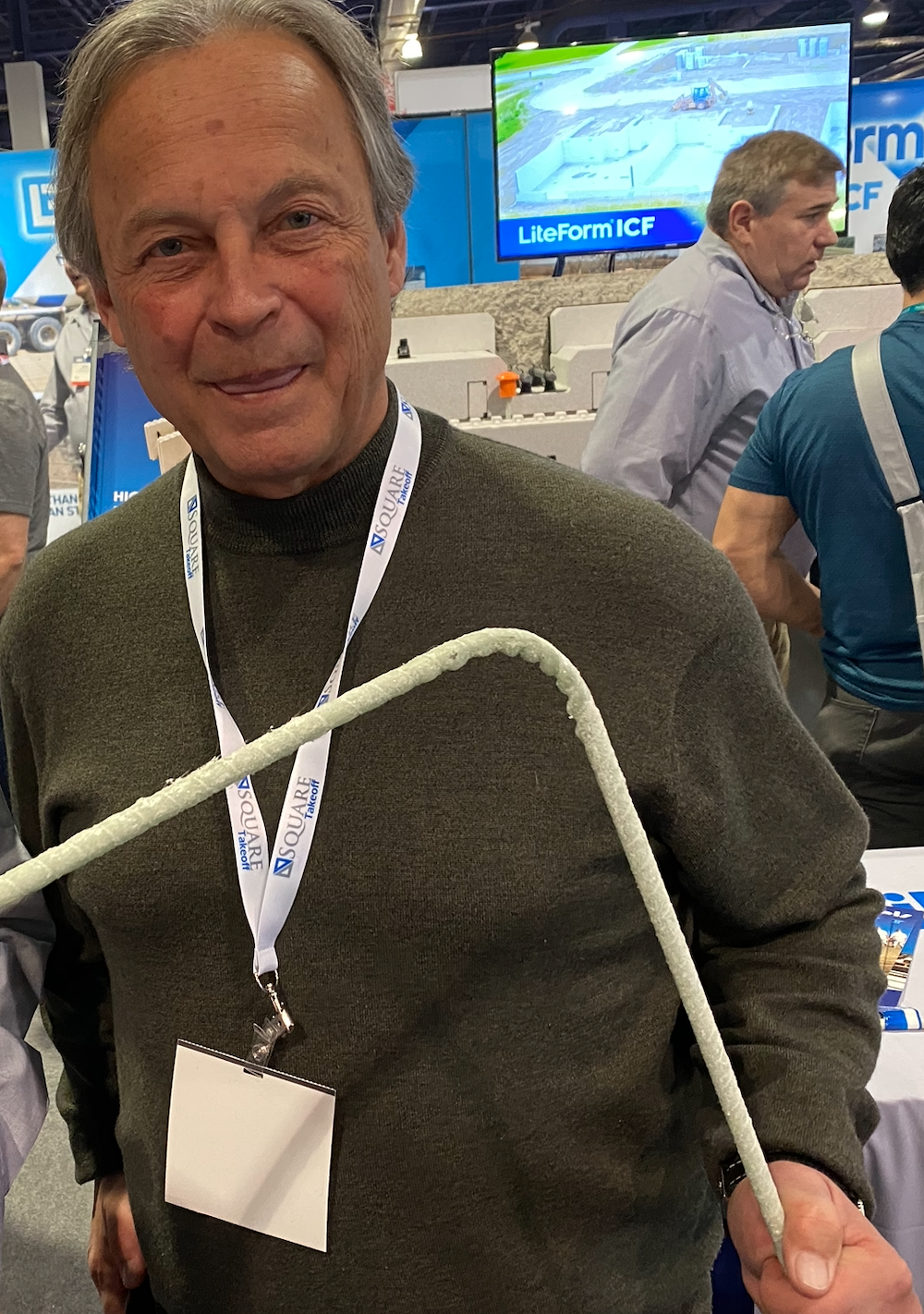
Photograph 4 – Fiberglass Re-Bars - Non-conductive reinforcing bars - awesome. Notice the big smile on the building science guy….
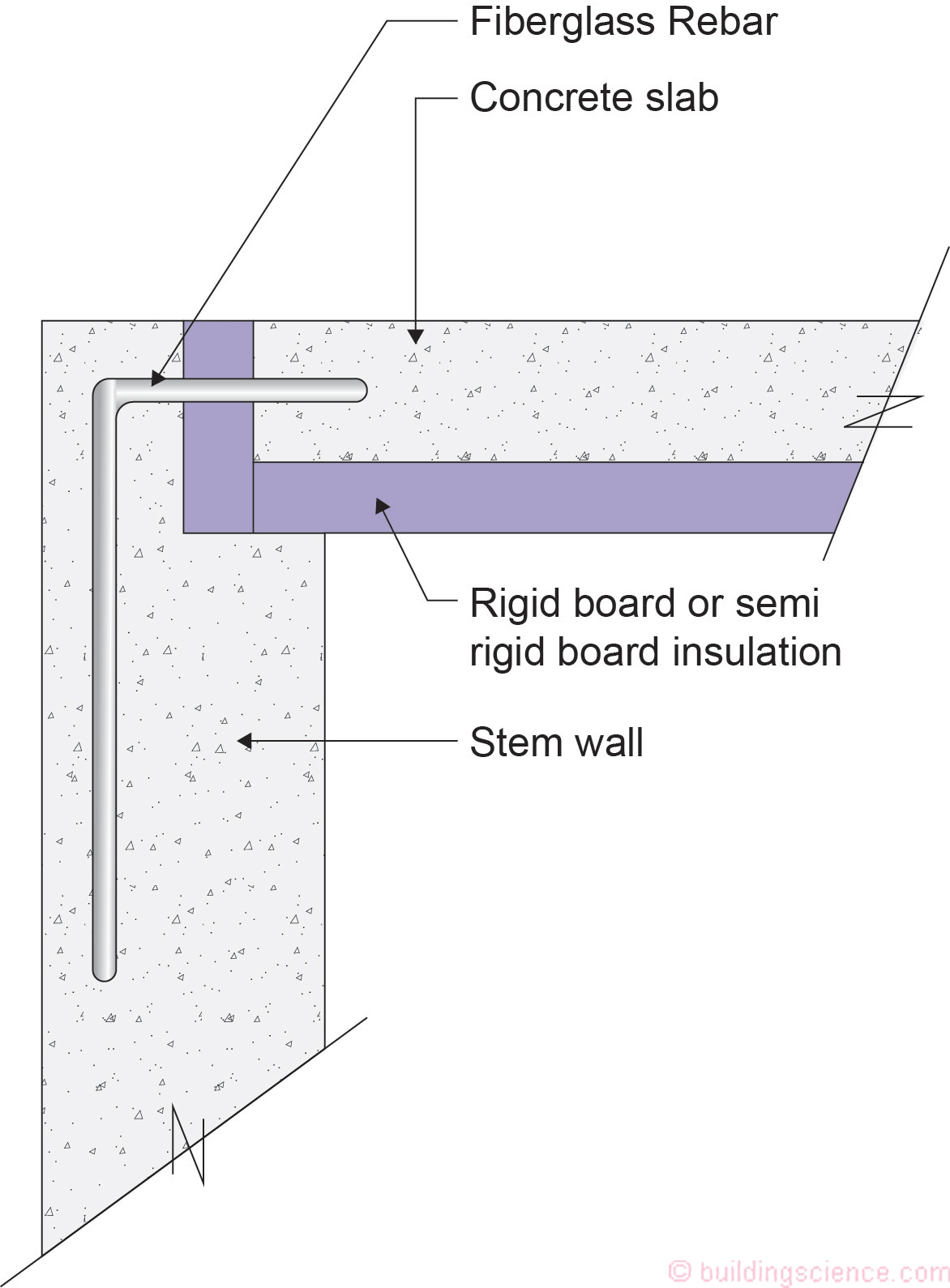
Figure 5: Fiberglass Rebar Providing Structural Connection Between Stem Wall and Slab
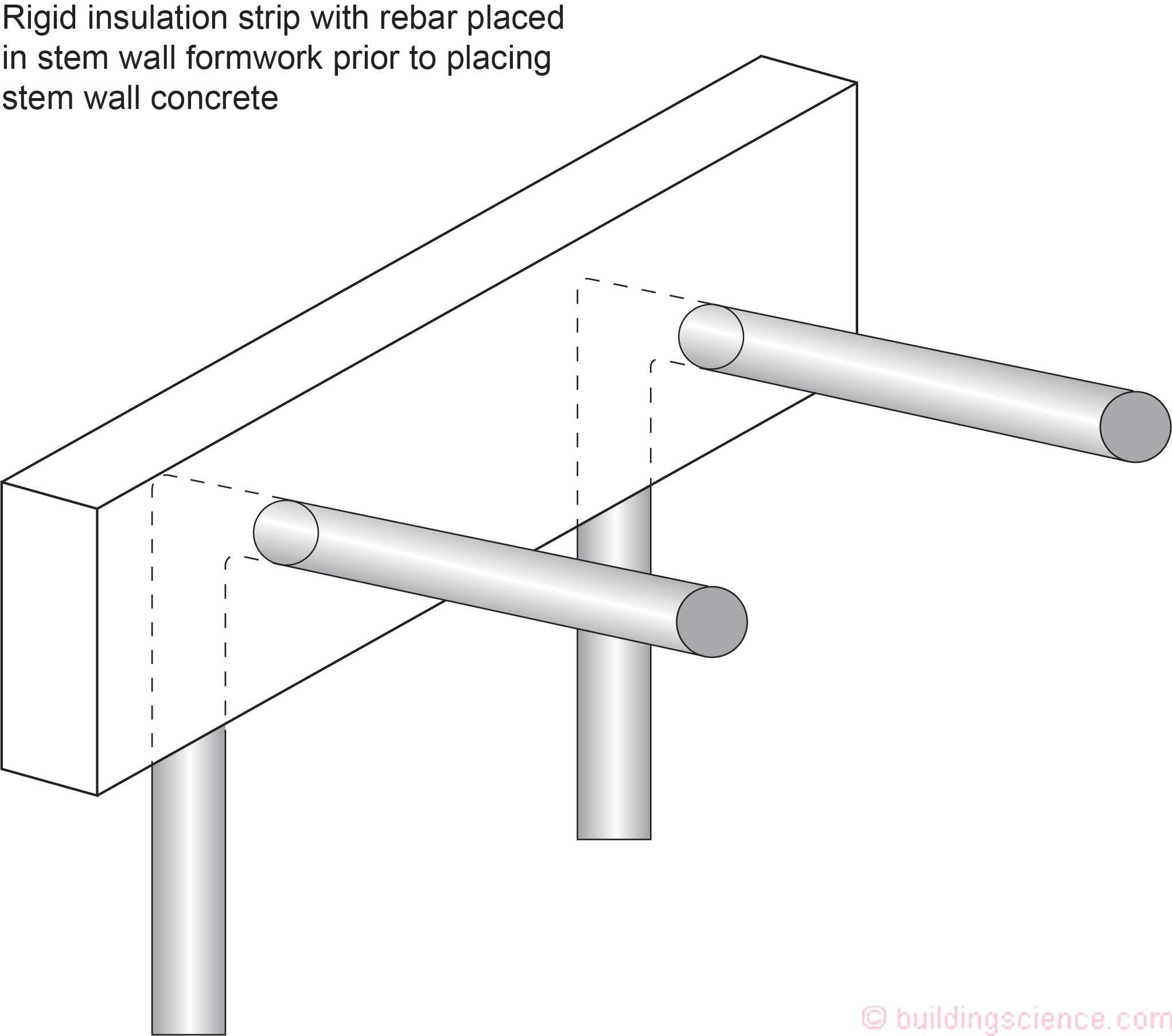
Figure 6: Rigid Insulation Strip With Rebar Placed In Stem Wall Formwork Prior to Placing Stem Wall Concrete
If you have bad soil conditions you are going to end up with a monolithic slab/grade beam that may also be post tensioned. With these assemblies the insulation can be installed on the exterior of the slab edge/grade beam extending vertically to the bottom of the grade beam or can be installed on the top of slab.
Figure 7 shows a monolithic slab/grade beam with exterior slab edge insulation. It is key in assemblies with exterior slab edge/grade beam insulation be protected during the construction process and over the useful service life of the building by a protection board or panel. The panel can be metal, cement board or cellular PVC. If cement board is used, it should be a type that is not reinforced with wood fibers, or if it does contain wood fibers, it should be coated with acrylic latex paint on all six sides to protect it from water damage. This protection board also needs to deal with critters such as rodents. Don’t underestimate the animal kingdom. I particularly hate mice.
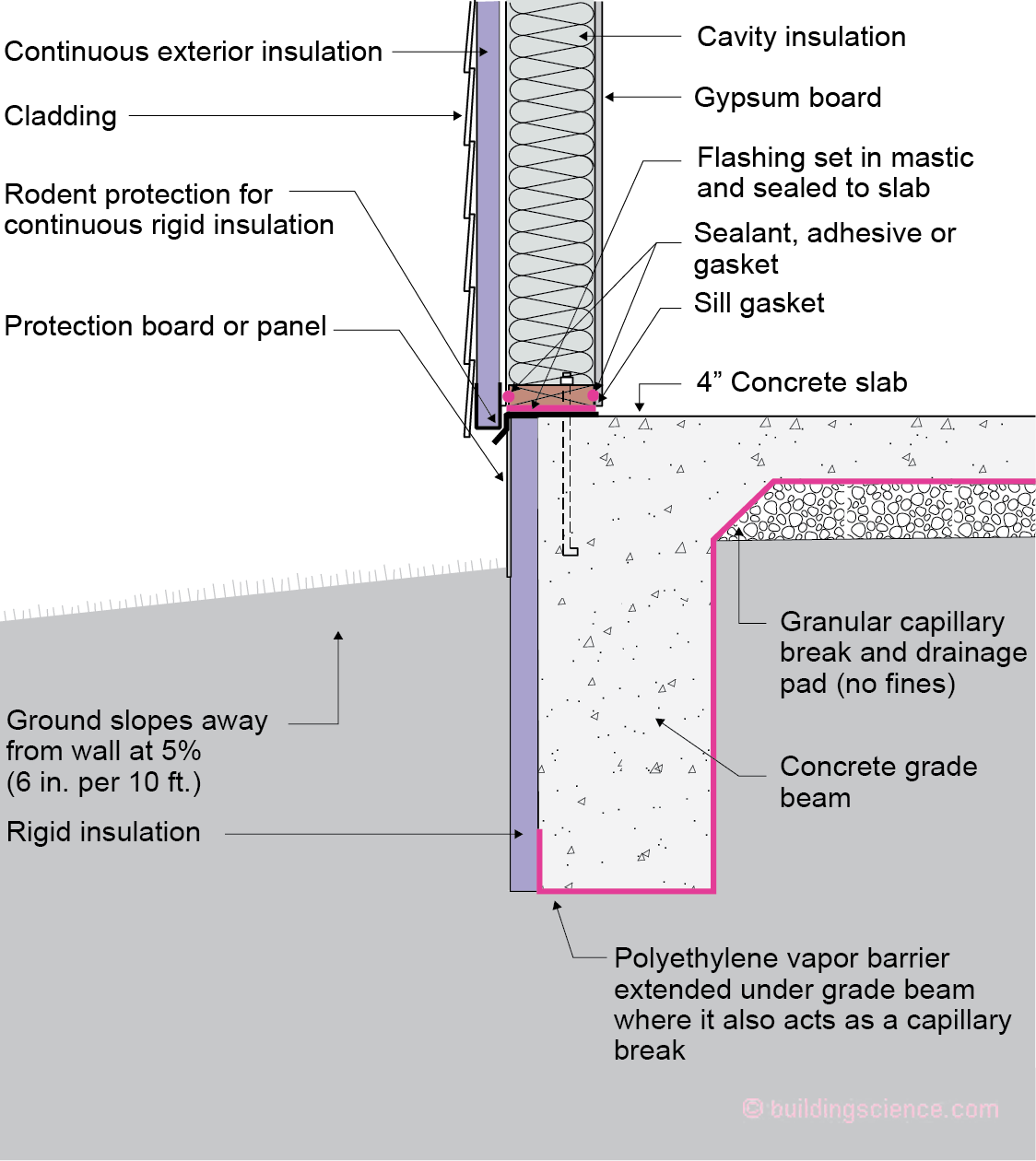
Figure 7: Monolithic Slab/Grade Beam With Exterior Slab Edge Insulation
Additionally, a stainless steel flashing should be installed over the top of the exterior slab edge insulation bridging the gap between the top of the slab and the perimeter protection board. This rigid flashing acts as a capillary break providing moisture control and acts as a termite, insect and rodent barrier. This flashing should be fully adhered to the top of the slab edge foundation in mastic.
Stainless steel flashings are recommended due to the lower thermal transmission of stainless steel compared to carbon steel and for their significant resistance to corrosion.
The exterior slab edge/grade beam insulation should be non-moisture sensitive rigid board insulation such as extruded polystyrene (XPS) or semi rigid board insulation such as mineral wool/stone wool or fiberglass.
In some jurisdictions it may be necessary to provide a removable strip of insulation and protection board to allow for termite inspection (Figure 8). The removable strip of rigid insulation is bonded/adhered to the protection board strip and is thicker than the lower slab edge insulation. The removable protection board strip is cantilevered over the lower protection board and screwed in place to the lower protection board
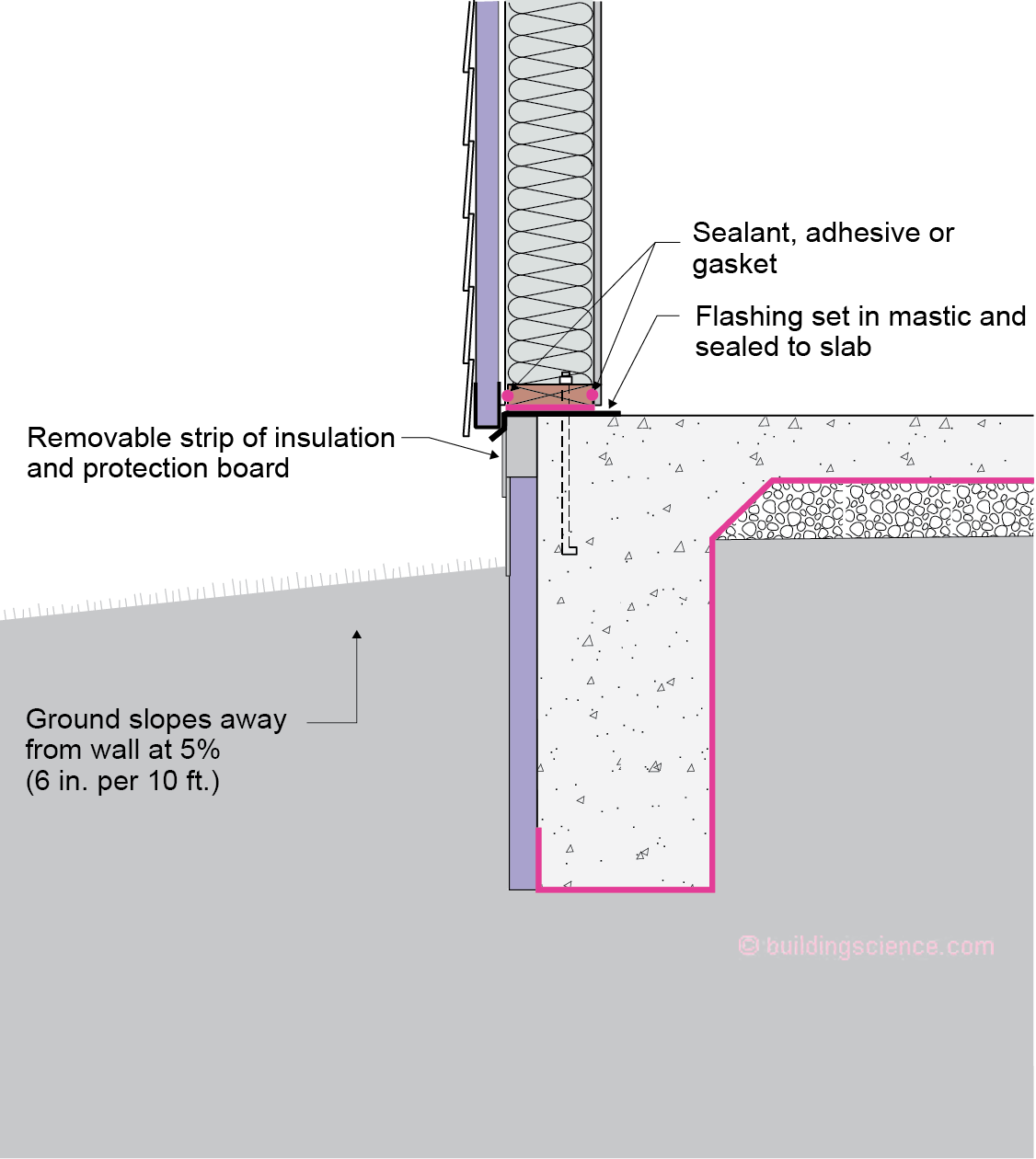
Figure 8: Monolithic Slab/Grade Beam With Exterior Slab Edge Insulation With Removal Inspection Strip
The removable strip of rigid insulation is bonded/adhered to the protection board strip and is thicker than the lower slab edge insulation. The removable protection board strip is cantilevered over the lower protection board and screwed in place to the lower protection board
Figure 9, Figure 10, Figure 11 and Figure 12 show monolithic slab/grade beam assemblies with top surface slab insulations. Both rigid (extruded polystyrene (XPS), expanded polystyrene (EPS) or isocyanurate) and semi rigid board insulations (mineral wool/stone wool or fiberglass) are shown.
Note the bearing plate under the exterior wall and interior load bearing wall. Note the building paper/house wrap over the top of the rigid insulation to provide a slip surface and to protect the assembly from liquids spilled on the finished floor during service.
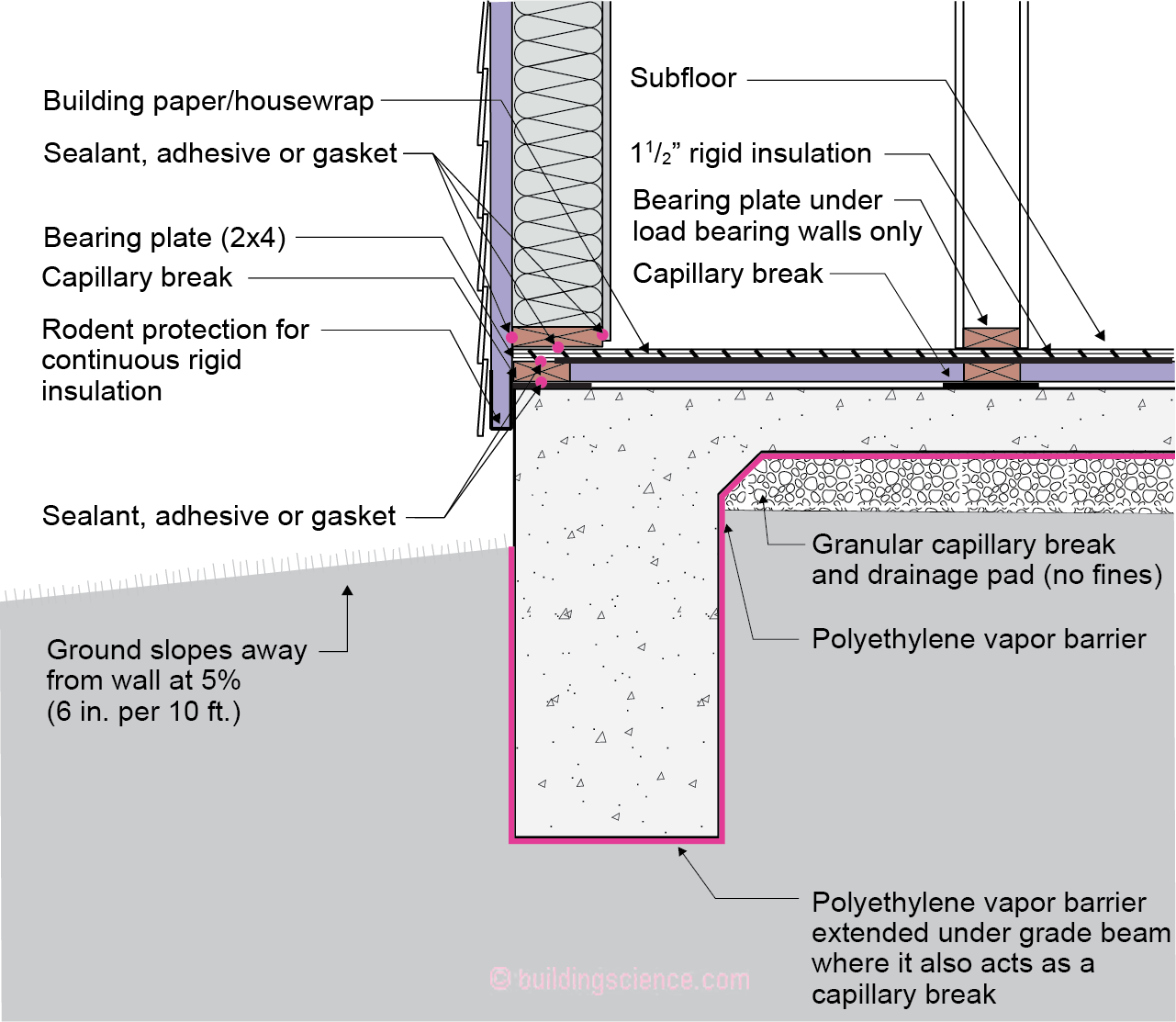
Figure 9: Monolithic Slab/Grade Beam With Top Surface Slab Insulation
Note the bearing plate under the exterior wall and interior load bearing wall. Note the building paper/house wrap over the top of the rigid insulation to provide a slip surface and to protect the assembly from liquids spilled on the finished floor during service. Rigid insulation such as extruded polystyrene (XPS), expanded polystyrene (EPS) or isocyanurate.
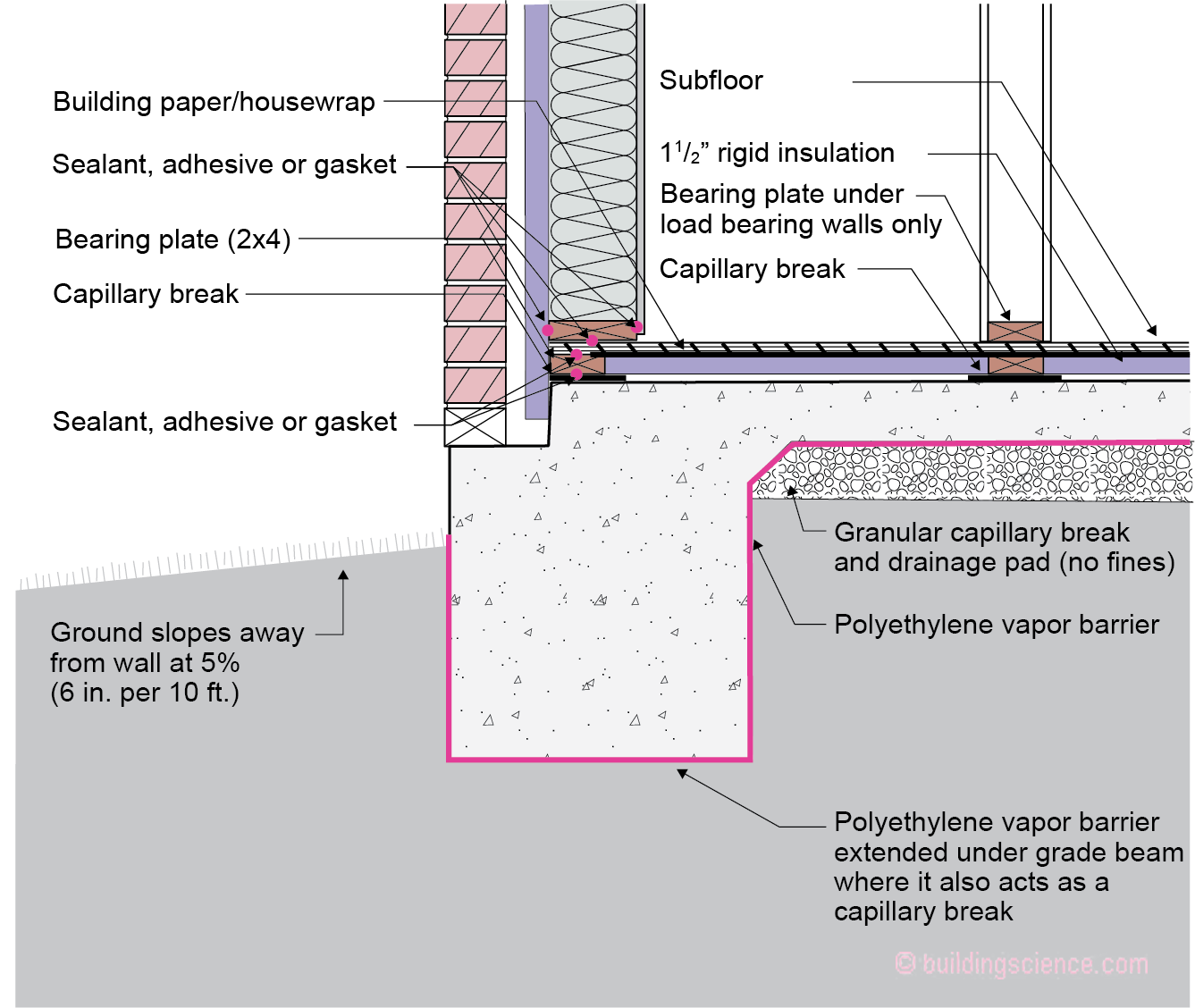
Figure 10: Monolithic Slab/Grade Beam With Top Surface Slab Insulation And Brick Veneer
Note the bearing plate under the exterior wall and interior load bearing wall. Note the building paper/house wrap over the top of the rigid insulation to provide a slip surface and to protect the assembly from liquids spilled on the finished floor during service. Rigid insulation such as extruded polystyrene (XPS), expanded polystyrene (EPS) or isocyanurate.
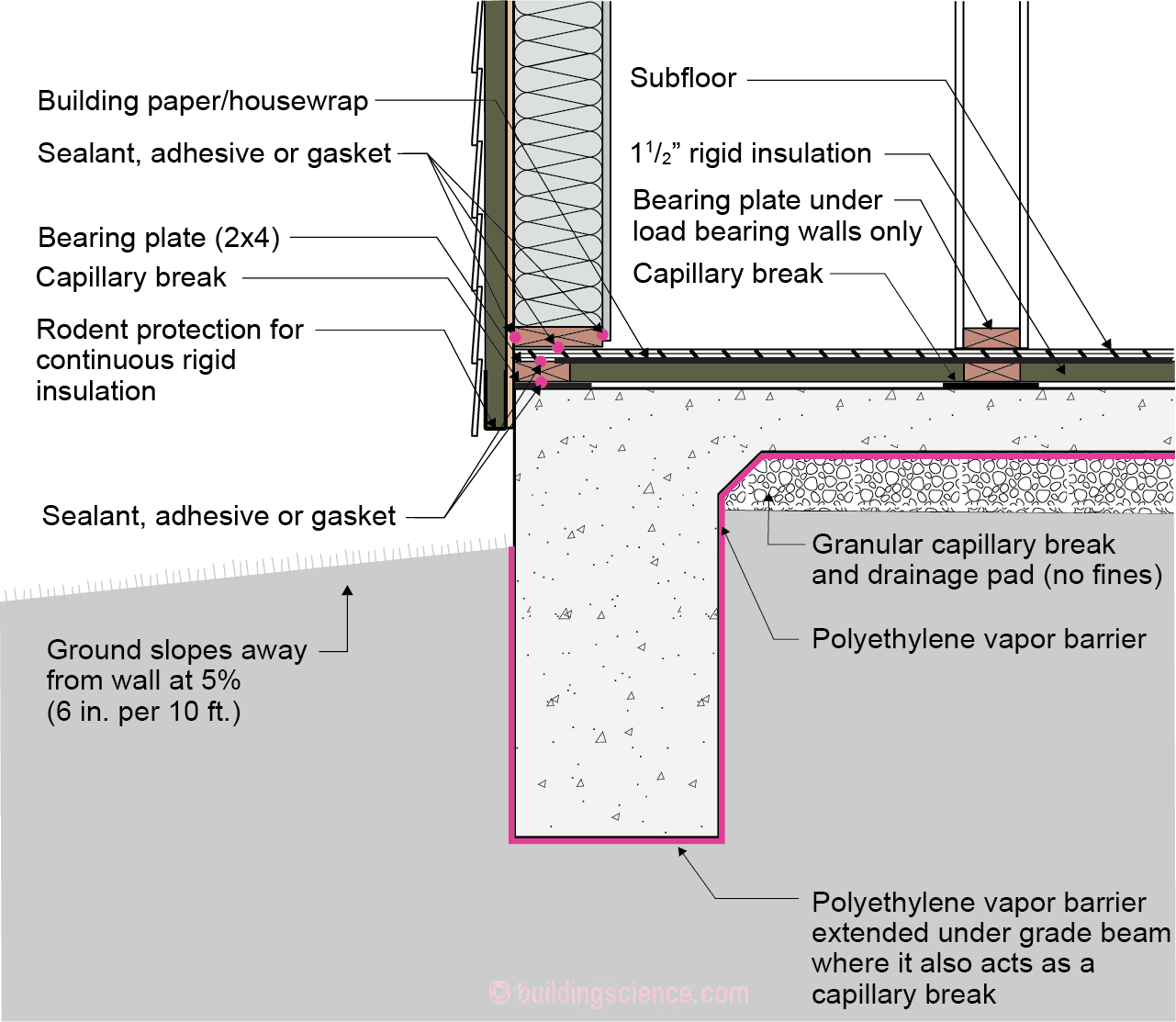
Figure 11: Monolithic Slab/Grade Beam With Top Surface Slab Insulation
Note the bearing plate under the exterior wall and interior load bearing wall. Note the building paper/house wrap over the top of the rigid insulation to provide a slip surface and to protect the assembly from liquids spilled on the finished floor during service. Semi rigid board insulation such as mineral wool/stone wool or fiberglass.
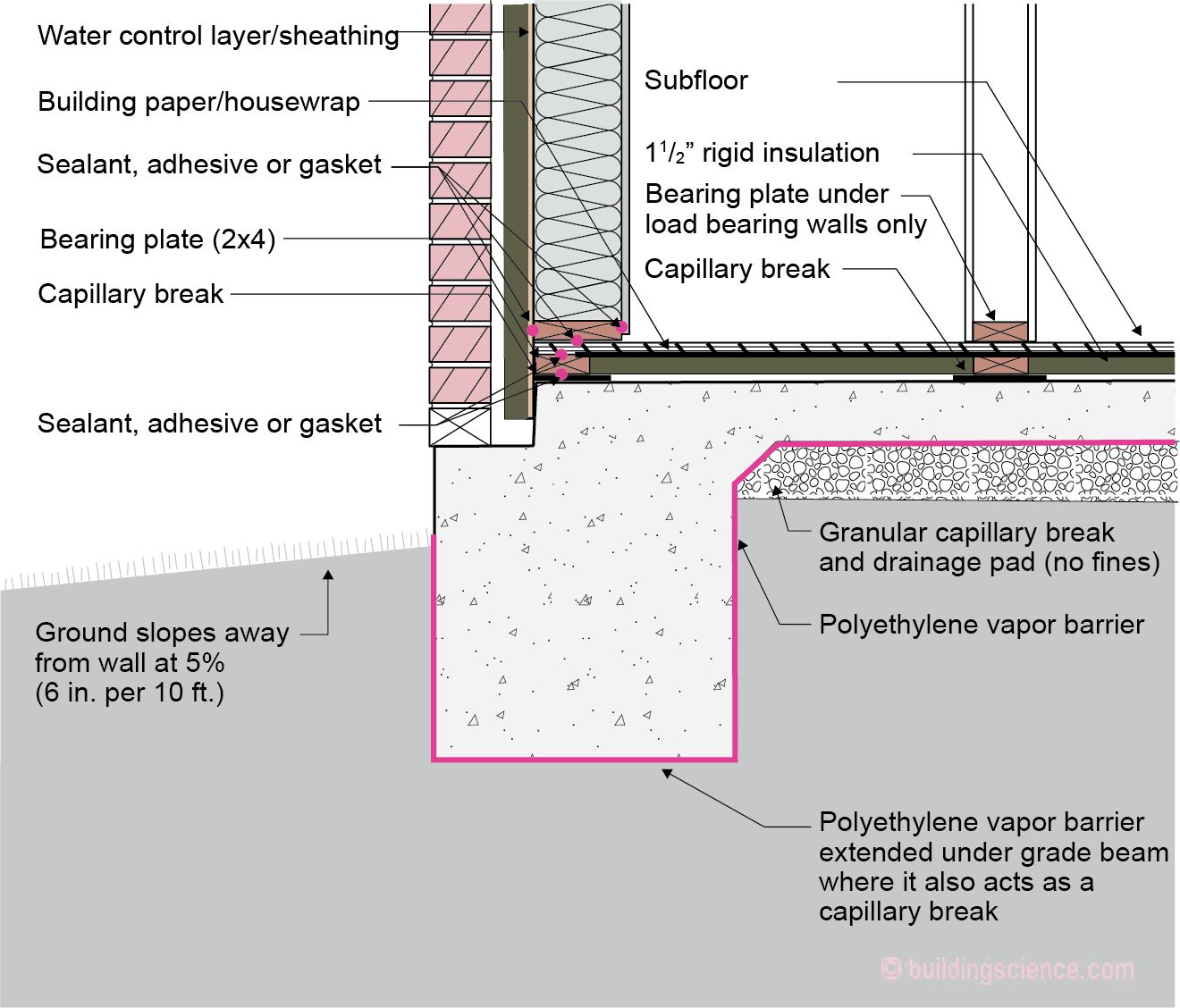
Figure 12: Monolithic Slab/Grade Beam With Top Surface Slab Insulation And Brick Veneer
Note the bearing plate under the exterior wall and interior load bearing wall. Note the building paper/house wrap over the top of the rigid insulation to provide a slip surface and to protect the assembly from liquids spilled on the finished floor during service. Semi rigid board insulation such as mineral wool/stone wool or fiberglass.
Figure 13 shows a thermally broken slab edge insulation approach with a brick veneer. A separate concrete grade beam is used to support the brick veneer. Note the stainless steel flashing set in mastic and sealed to the slab and sealed to the concrete grade beam for the brick veneer. Also note the use of a fiberglass tie connecting the grade beam to the monolithic slab/grade beam assembly.
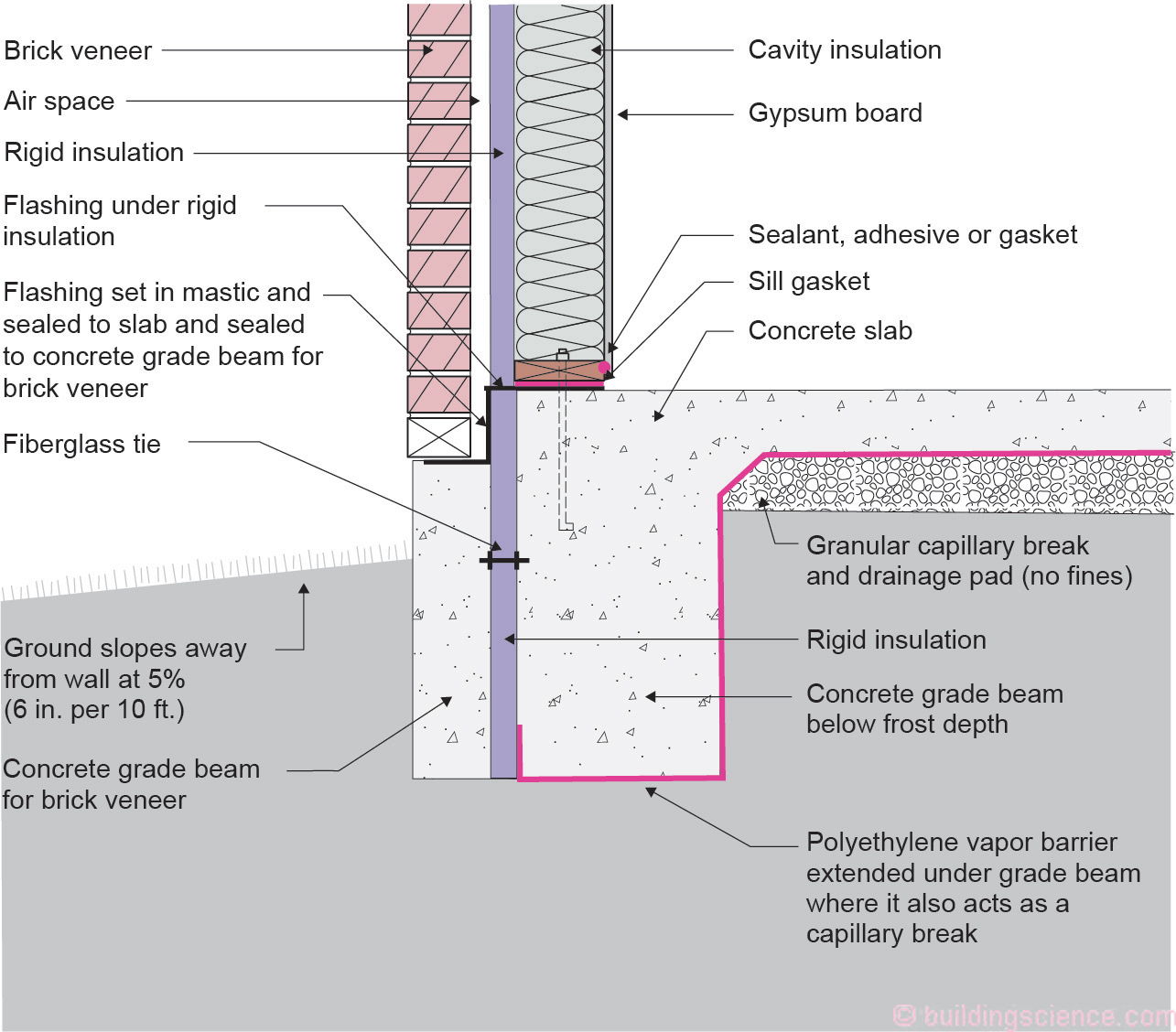
Figure 13: Monolithic Slab/Grade Beam With Exterior Slab Edge Insulation and Brick Veneer
Note the stainless steel flashing set in mastic and sealed to the slab and sealed to the concrete grade beam for the brick veneer.
Post-tensioned monolithic grade beams can be externally insulated after the post tensioning has occurred. The installation of the external slab edge insulation requires coordination with the timing of the post tensioning and the framing of structure above. Figure 14 and Figure 15 illustrate a two- step process. Rigid insulation placed in formwork prior to placing concrete leaving upper portion of slab edge uninsulated allowing for post tensioning to occur. Then, a top layer of rigid insulation strip and protection board or panel is installed after post tensioning. Garage slab foundations should be thermally uncoupled from house slab foundations. No special details are required for stem wall foundations internally insulated as the house slab is thermally uncoupled from the entire perimeter of the house foundation stem wall.
When the slab is cast simultaneously with a grade beam creating a monolithic assembly insulation should be installed between the garage slab foundation and the house slab foundation on the exterior of the slab edge/grade beam of the house foundation extending vertically to the bottom of the grade beam (Figure 16). The details are similar to the typical approach for the non-garage portion of the house foundation.
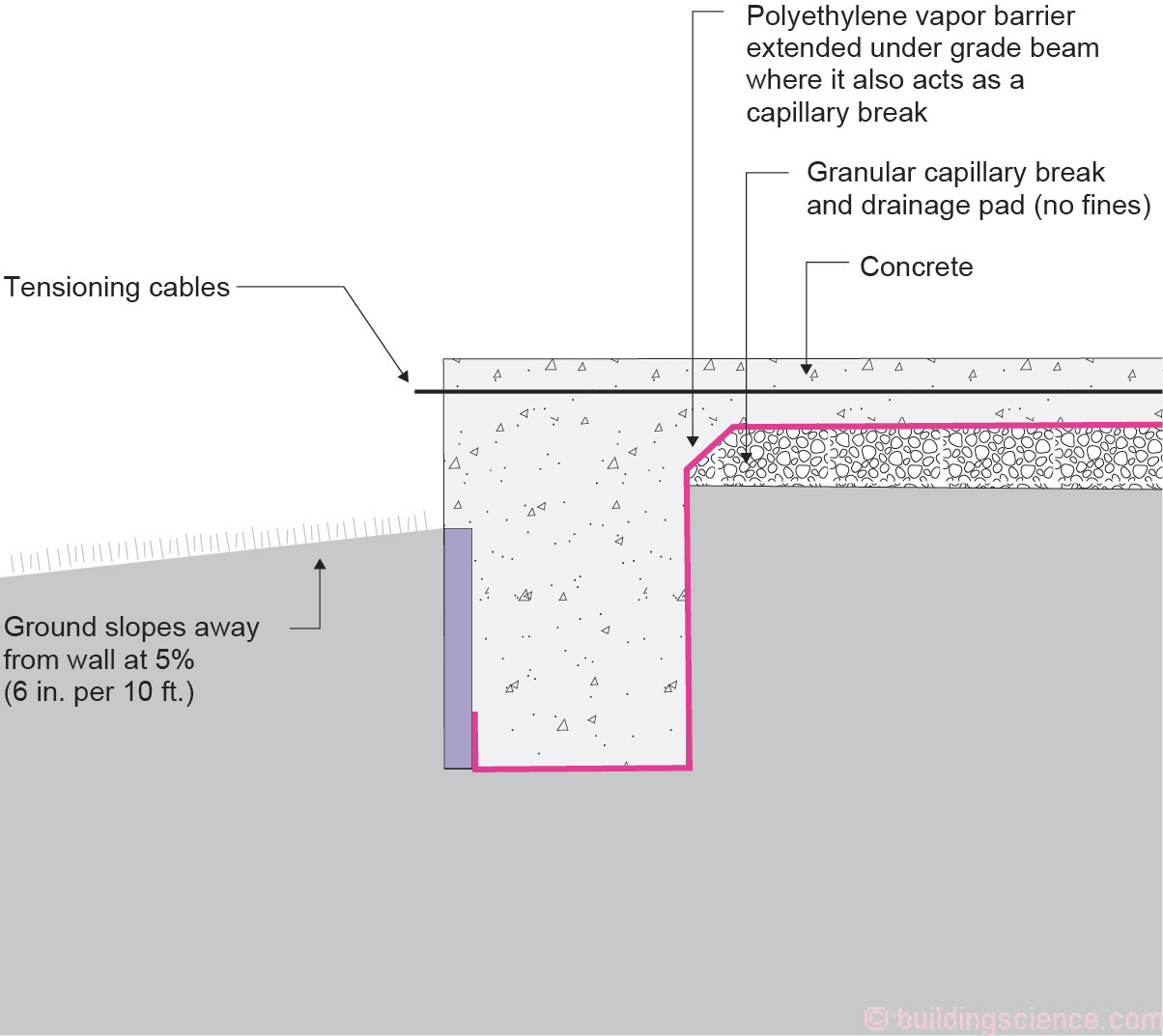
Figure 14: Post Tensioned Monolithic Slab/Grade Beam Externally Insulated Rigid insulation placed in formwork prior to placing concrete leaving upper portion of slab edge uninsulated allowing for post tensioning to occur.
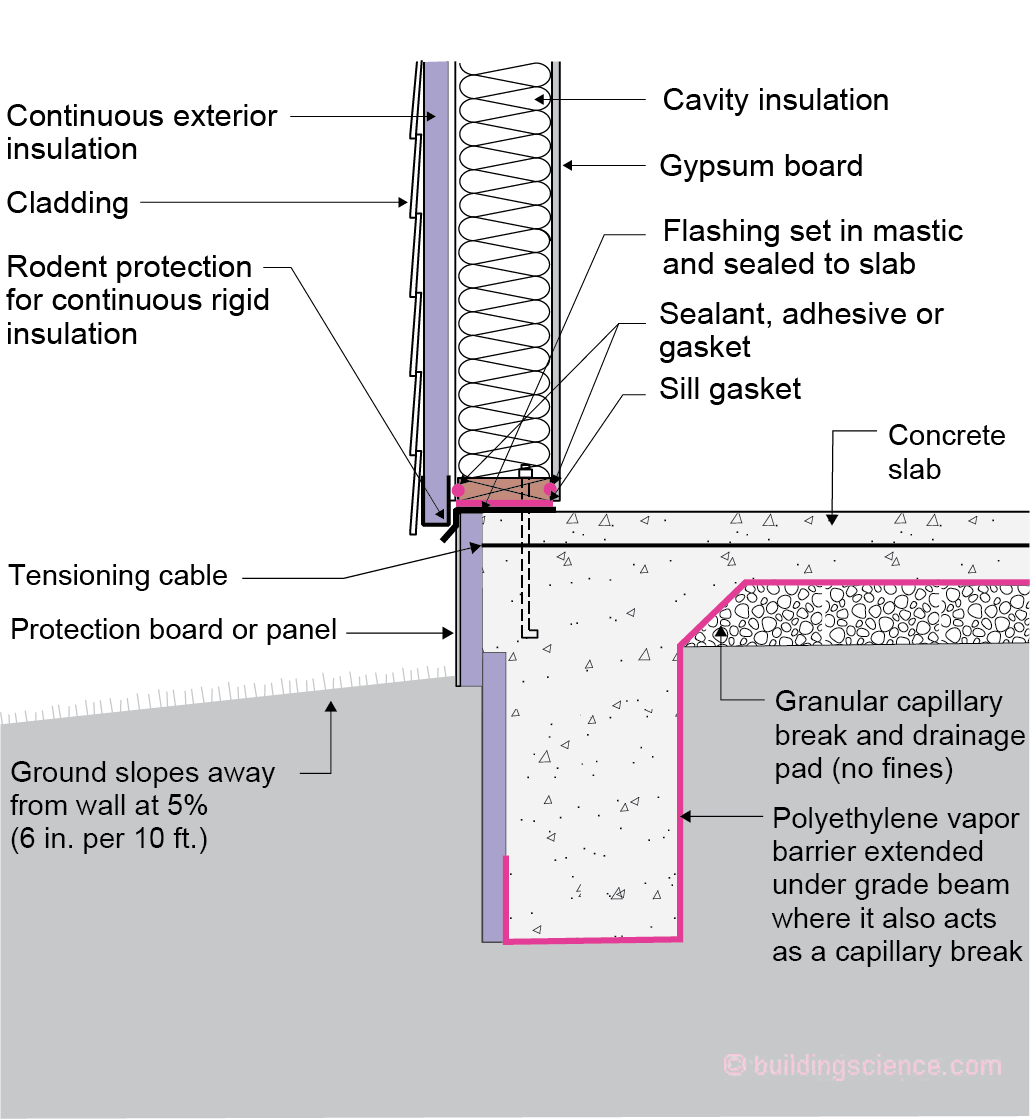
Figure 15: Post Tensioned Monolithic Slab/Grade Beam Externally Insulated Top layer of rigid insulation strip and protection board or panel installed after post tensioning.
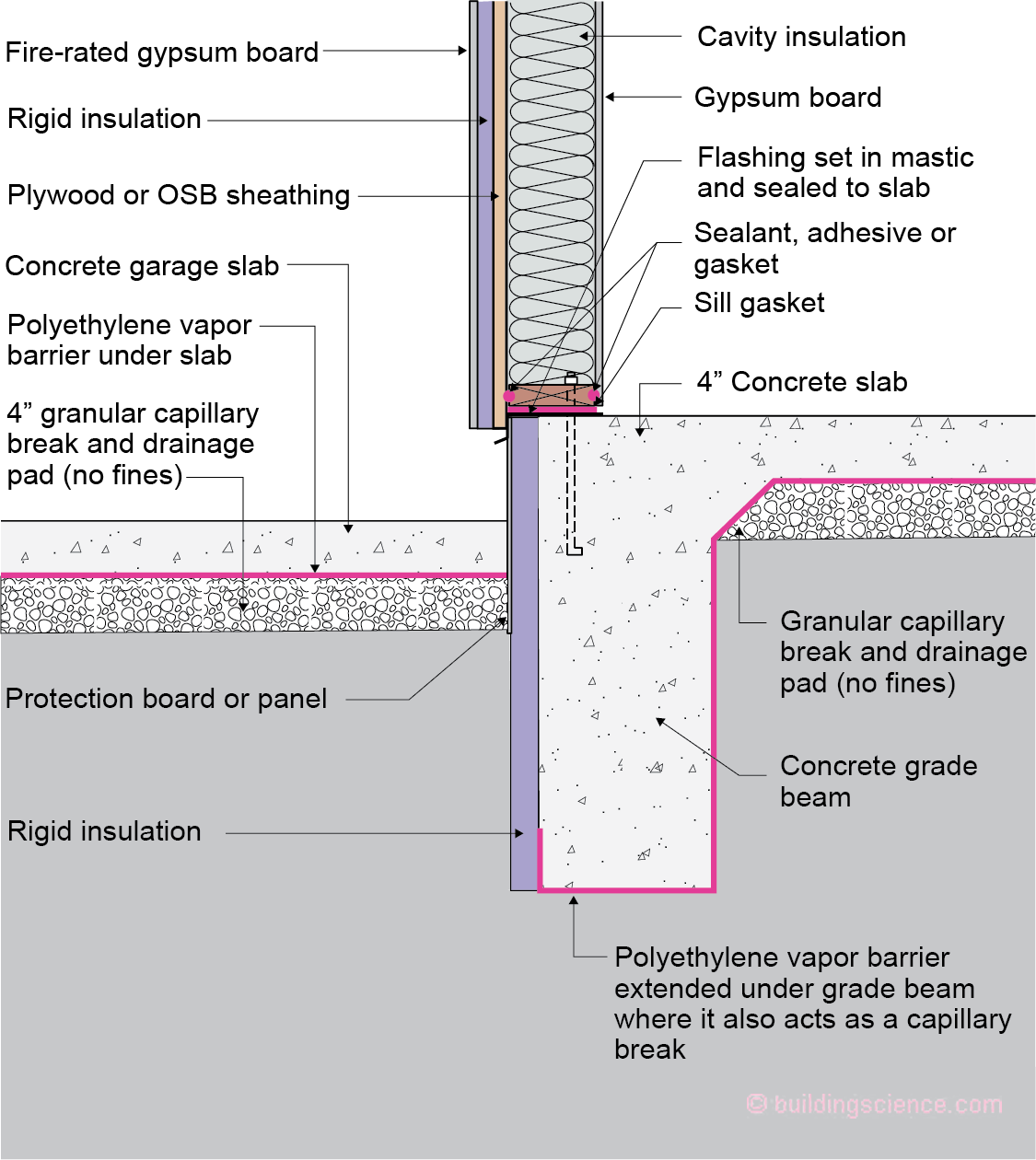
Figure 16: Garage To House Foundation With Monolithic Grade Beam
For exterior stair connections no special details are required for stem wall foundations internally insulated as the house slab is thermally uncoupled from the entire perimeter of the house foundation stem wall.
When the slab is cast simultaneously with a grade beam creating a monolithic assembly insulation should be installed between the exterior stairs and the house slab foundation on the exterior of the slab edge/grade beam of the house foundation extending vertically to the bottom of the grade beam. The details are similar to the typical approach for the perimeter of the house foundation.
OK, whew. Things have changed in the past half-decade - termites, insects, structural loads, insulation materials, radon and soil gas, and codes. Insulating slab-on-grade foundations had to change to keep pace. You can pretty much use any insulation in any climate zone with any structural system. But at the end of the day don’t forget about the insect kingdom and the animal kingdom and the humans that have to build the stuff.
[1] You connect them when your structural engineer tells you to connect them. Don’t mess with your structural engineer. Chat with your structural engineer and ask why…and there is usually a very good reason. Structural engineers love it when someone talks to them…because things are typically very boring for them. Pretty much they have figured out how to make everything work. Not like mechanical engineers. Things are not boring for mechanical engineers because nothing works and we typically blame the architect…
[2] But, but, but…there is a test that shows we can submerge XPS insulation in a tub of water for a year…and then take it out and weigh it…see it does not absorb any water. Ah, yes….but now put one side of the XPS in contact with the water and create a temperature difference across the insulation…different result, eh? What are the odds that you will have thermal gradient across thermal insulation? Yes, the submerged water test is another stupid test method that should be ignored…right up there with putting a 20 inch water column on a building wrap or house wrap that does not have nail holes or screw holes….what are the odds that you are going to have nail holes or screw holes when you attach cladding with…wait for it…nails or screws?
[3] In some jurisdictions an independent inspection agency may be required to inspect and certify such termite control prior to commencing framing.
[4] The material cost of the insulation is low compared to the installation cost itself. IECC does not require slab insulation for Climate Zone 3 and I think that is a big mistake. Can’t retrofit slab foundations easily. Why should you believe me? Ah, every time I have made a thermal resistance recommendation over the years I have pretty much ended up being wrong….I have consistently been too low.
